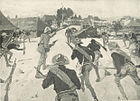Gubat ti Filipino–Amerikano
| Gubat ti Filipino–Amerikano | |||||||||
|---|---|---|---|---|---|---|---|---|---|
      Agpakanawan manipud itingato: Dagiti tropa ti Estados Unidos iti Manila, ni Gregorio del Pilar ken dagiti tropana idi agarup a 1898, Dagiti Amerikano nga agguarguardia iti rangtay ti Karayan Pasig idi 1898, Gubat ti Santa Cruz, Dagiti soldado ti Filipinas iti Malolos, Gubat ti Quingua. | |||||||||
| |||||||||
| Dagiti makigubgubat | |||||||||
|
Limitado a Ganganaet a Suporta: | |||||||||
| Dagiti agbilbilin ken daulo | |||||||||
|
|
| ||||||||
| Kapigsa | |||||||||
| ≈24,000 to ≈44,000 kapigsa ti pagbabakalan[5] |
agarup a 80,000–100,000 ≈Kadawyan & Di-kadawyan | ||||||||
| Dagiti nadangran ken natnatay | |||||||||
| 4,234[6]–6,165 killed,[7] 2,818 a nasugatan[6] | 12,000[3]–20,000[8] napatay | ||||||||
| Dagiti paisano a Filipino: 200,000–250,000 a natay, kaaduan manipud iti sakit[8][9][10][ii] | |||||||||
| |||||||||
Ti Gubat ti Filipinoe–Amerikano (Espaniol: Guerra Filipino-Estadounidense, Filipino: Digmaang Pilipino-Amerikano) (1899–1902)[11] ket maysa idi a suppiat a nagbaetan ti Umuna a Republika ti Filipinas (Espaniol: República Filipina) ken ti Estados Unidos.
Nangrugi ti suppiat idi saan a kinayat ti Umuna a Republika ti Filipinas dagiti termino ti Tulag ti Paris babaen ti panangala ti Estados Unidos iti Filipinas manipud ti Espania a nangpasardeng ti Gubat ti Espaniol–Amerikano.[12][13] Ti gubat ket ti panagtuloy ti salisal para iti wayawaya ti Filipinas a nangrugi di 1896 iti Yaalsa ti Filipinas.
Nangrugi ti panaglaban dagiti puersa ti Estados Unidos ken ti Republika Filipina idi Pebrero 4, 1899, ken napardas a kimmaro iti Maikadua a Gubat ti Manila idi 1899 . Idi Hunio 2, 1899, opisial nga inrangarang ti Umuna a Republika ti Filipinas ti gubat a panagsuppiat iti Estados Unidos.[14] Ti gubat ket opisial a nagpatingga idi Hulio 2, 1902,[15] a nagballigi met ti Estados Unidos. Nupay kasta, adda met dagiti dadduma a grupo ti Filipinas nga indauluan dagiti beterano iti Katipunan a nagtultuloy a nakilaban kadagiti puersa ti Amerikano. Kadagitoy idi a daulo ket ni Heneral Macario Sacay, ti beterano a miembro ti Katipunan a nangituloy ti presidensia iti nairangarang a "Republika ti Tagalog", a naporma idi 1902 kalpasan ti pannakatiliw ni Presidente Emilio Aguinaldo. Dagiti dadduma agrupo, mairaman dagiti tattao a Moro ken dagiti tattao a Pulahanes, ket nagtultuloyda kadagiti panagsuppiat kadagiti adayo a lugar ken dagiti isla aginggana iti kanungpalan a pannakaabakda kalapsan ti maysa a dekada iti Gubat ti Bud Bagsak idi Hunio 15, 1913.[2]
Dagiti nota
[urnosen | urnosen ti taudan]- ^ a b "Diplomatic relations between the Philippines and Japan". Republic of the Philippines – Presidential Museum & Library. Naala idi 1 Hunio 2015.
On Pebrero 4, 1899, the Philippine-American War broke out. A handful of Japanese shishi, or ultranationalists, fought alongside President Aguinaldo’s army. They landed in Manila, led by Captain Hara Tei and joined Aguinaldo’s forces in Bataan.
[permanente a natay a silpo] - ^ a b Constantino 1975
- ^ a b "Historian Paul Kramer revisits the Philippine–American War", The JHU Gazette, Johns Hopkins University, 35 (29), Abril 10, 2006, naala idi Marso 18, 2008
- ^ Deady 2005, p. 62
- ^ Ramsey 2007, p. 115
- ^ a b Stanley Karnow (24 Nobiembre 2010). In Our Image: America's Empire in the Philippines. Random House Publishing Group. p. 375. ISBN 978-0-307-77543-6.
The U.S. toll was 4,234 dead and 2,818 wounded-and thousands later succumbed at home to diseases contracted in the islands.
- ^ Hack & Rettig 2006, p. 172
- ^ a b Guillermo, Emil (Pebrero 8, 2004), "A first taste of empire", Milwaukee Journal Sentinel: 03J, naiyarkibo manipud iti kasisigud idi 2012-12-08, naala idi 2016-08-03
- ^ Smallman-Raynor 1998
- ^ Burdeos 2008, p. 14
- ^ Wolters, W.G. (2004), "Philippine War of Independence", iti Keat Gin Ooi (ed.), Southeast Asia: A historical encyclopedia from Angkor Wat to East Timor, vol. II, Santa Barbara, CA: ABC-CLIO, ISBN 1-57607-770-5
- ^ Treaty of Peace Between the United States and Spain; December 10, 1898, Yale University
- ^ Carman Fitz Randolph (2009), "Chapter I, The Annexation of the Philippines", The Law and Policy of Annexation, BiblioBazaar, LLC, ISBN 978-1-103-32481-1
- ^ Kalaw 1927, pp. 199–200
- ^ Worcester 1914, p. 188
Adu pay a mabasbasa
[urnosen | urnosen ti taudan]- Delmendo, Sharon (2004), The Star-Entangled Banner: One Hundred Years of America in the Philippines, Rutgers University Press, ISBN 0-8135-3411-9
- Jacobson, Matthew Frye. (2000). Barbarian Virtues: The United States Encounters Foreign Peoples at Home and Abroad, 1876–1917. Hill and Wang, ISBN 978-0-8090-1628-0
- Legarda, Benito J. Jr. (2001). The Hills of Sampaloc: the Opening Actions of the Philippine–American War, Pebrero 4–5, 1899. Makati: Bookmark. ISBN 978-971-569-418-6.
- Silbey, David J. A War of Frontier and Empire: The Philippine–American War, 1899–1902 (2008)
- Stewart, Richard W. General Editor, Ch. 16, Transition, Change, and the Road to war, 1902–1917" Naiyarkibo 2012-01-12 iti Wayback Machine, in "American Military History, Volume I: The United States Army and the Forging of a Nation, 1775–1917" Naiyarkibo 2011-12-27 iti Wayback Machine, Center of Military History, United States Army, ISBN 0-16-072362-0.
- Wilcox, Marrion. Harper's History of the War. Harper, New York and London 1900, reprinted 1979. [Alternate title: Harper's History of the War in the Philippines]. Also reprinted in the Philippines by Vera-Reyes.
Dagiti silpo ti ruar
[urnosen | urnosen ti taudan]![]() Dagiti midia a mainaig iti Gubat ti Filipino–Amerikano iti Wikimedia Commons
Dagiti midia a mainaig iti Gubat ti Filipino–Amerikano iti Wikimedia Commons
